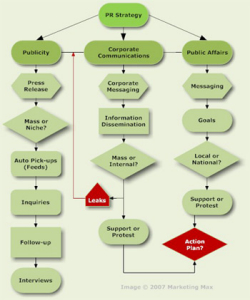That’s what a recent survey would have us believe:
There’s a vacuum in strong leadership in the public relations and communications industry, at least that’s what top US PR leaders themselves say, according to a study released today by Heyman Associates and the University of Alabama.
Nearly 30 percent of those responding to the question said nobody came to mind when asked to name a PR leader.
Democratic presidential candidate Sen. Barack Obama was cited most often as the nation’s most effective communications leader in response to the open-ended question — but he was named by just 4 percent of all those surveyed.
Others named nearly as often as Obama were Republican presidential hopeful Sen. John McCain, former President Bill Clinton, Sen. Hillary Clinton and former Democratic presidential candidate Al Gore.Public-relations professionals mentioned most often were Harold Burson, founder of Burson-Marsteller; Richard Edelman, president and CEO of Edelman, and Jon Iwata, IBM’s marketing and communications chief.
“Politicians and celebrities were named more often than PR specialists because those who stayed on message and were highly visible in national media were the true leaders in the field, not those who worked behind the scenes,” said Dr. Bruce Berger, who chairs the Advertising and PR program at Alabama. “But the largest number of respondents simply said they couldn’t name a leader.”
The online poll of 222 PR practitioners was conducted as part of a national study — ”Excellence in Public Relations Leadership” — by graduate students attending Alabama’s Advertising and PR program. The report examines the key attributes of communications leadership and the qualities deemed most important by practitioners.
The survey found that the most important qualities of PR leaders include the following:
- Strategic decision-making: More than half of respondents said the most important quality among PR leaders is strategic decision-making — an ability to fully understand what drives an organization’s business and to develop working partnerships with organizational leaders.
- Exposure to sources of leadership skills and development: Work experiences, individual initiative, and access to role models are typically the richest sources of leadership skills and development; the lowest-ranked factors cited include training and genetics.
- Strong role models: Role models exert the greatest influence on beliefs about leadership values, practices, and questions; role models were described as exemplifying strong values and ethics (especially in times of crisis and tumult), possessing strong communication and strategic-thinking skills, and leading by example.
About the research: The project, launched in February 2008, included a deliberate sample of 1,000 diverse and experienced PR professionals selected from databases maintained by Heyman Associates. Among the 1,000 who received the online survey, 222 completed it. The final survey included 72 questions on the dimensions of communications leadership, today’s leaders in the field and their success factors. Some 60 percent of the respondents were female and 40 percent were male.
Three observations on this:
1. In our shop we believe that if you are doing PR correctly, you’re invisible.
2. Politicians are not public relations practitioners, no matter what their PR people tell you.
3. Going to graduate school in public relations is a major waste of time and treasure — unless you just want to postpone the inevitable of joining the workforce and becoming a productive member of society.

